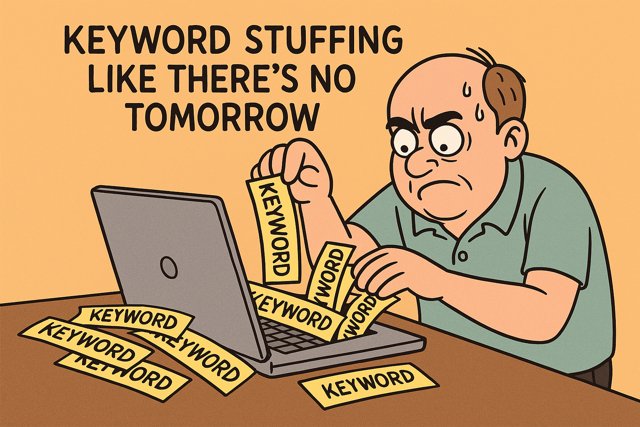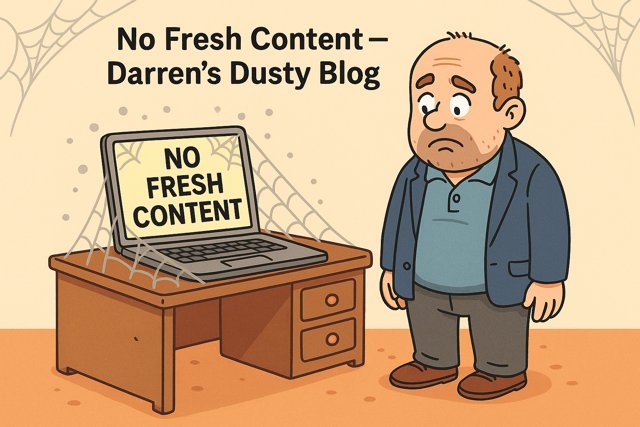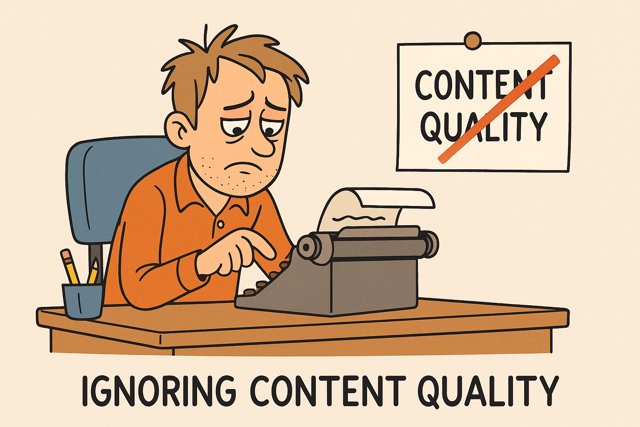Introduction: Darren’s SEO Disaster Story
SEO can feel like some dark art sometimes. But mostly it’s just about avoiding dumb SEO mistakes. Meet Darren — a bloke who thought buying 500 “high-quality” backlinks for £25 was a clever shortcut. Spoiler: It wasn’t. Darren got mugged down a back alley by the SEO police, lost his pink stilettos, and his rankings crashed harder than his dad’s old fishing boat.

Here’s what Darren (and you) should never do, plus how to fix it so your website actually gets clicks, leads, and maybe even sales.
1. Buying Cheap, Spammy Backlinks — Darren’s Downfall
Darren’s big idea was to pay LinkLord97 for 500 backlinks overnight. What could go wrong?
- The links were from spammy sites nobody visited.
- Google’s algorithm saw through it and slapped a penalty.
- Darren’s site disappeared from page 1 to page 99, fast.
Why it sucks: Google hates manipulative links. Quality > quantity. You’re better off with one link from a respected site than hundreds from shady blogs.
Fix it: Build links naturally. Guest post, create link-worthy content, or ask for mentions respectfully. Don’t be a Darren.
2. Ignoring Mobile Users — Darren’s Site Is a Pinch-and-Zoom Nightmare
Darren’s mate Dave uses his phone for everything — including shopping for rods. But Darren’s site? Not so friendly on mobile.
- Text too small to read.
- Buttons the size of a pea.
- Images overlapping text.
Google prioritizes mobile-friendly sites. If yours isn’t, you’re losing traffic and conversions.
Fix it: Use responsive design. Test your site on different devices. Tools like Google’s Mobile-Friendly Test will save you from embarrassing pinch sessions.
3. Slow Page Load — Darren Uploaded a 20MB Trout Pic… Oops
Nothing kills patience like a slow website. Darren’s 10-second load time was a dealbreaker.
- Large uncompressed images.
- Bloated themes with endless plugins.
- No caching or content delivery network (CDN).
Visitors bounce, rankings drop, and sales dry up.
Fix it: Compress images. Use modern formats like WebP. Pick lightweight themes and enable caching. Speed matters more than fancy animations.
4. Missing or Duplicate Meta Descriptions — Darren’s Missed Pitches
Meta descriptions are your elevator pitch in search results. Darren’s? Either missing or repeated across pages.
- Google often pulls random text if no description is present.
- Duplicate meta descriptions confuse search engines.
Fix it: Write unique, compelling meta descriptions for every page. Two lines that make people want to click — no pressure.
5. Keyword Stuffing Like There’s No Tomorrow

Darren thought throwing “cheap carp rod UK” a dozen times on every page was clever. Spoiler: It’s not.
- Keyword stuffing makes content unreadable.
- Google’s algorithm penalizes overuse.
- Real users get turned off by robotic text.
Fix it: Use keywords naturally. Focus on quality content that answers questions. Think human, not robot.
6. Ignoring Internal Linking — Darren’s Dead-End Site
Darren’s pages were islands. No links between them.
- Visitors got lost.
- Google couldn’t understand site structure.
- Page authority didn’t flow.
Fix it: Link related content naturally. Use descriptive anchor text like “see our carp rod buying guide.” Internal linking keeps users engaged and improves SEO.
7. Forgetting to Fix Broken Links — Darren’s 404 Party
Broken links are like potholes on your website’s road.
- Google lowers crawl budget on sites with many broken links.
- Visitors hit dead ends and leave frustrated.
- Darren had dozens of broken links from outdated blog posts and product pages.
Fix it: Regularly scan for broken links using tools like Screaming Frog or Google Search Console. Fix or redirect them ASAP.
8. Neglecting Schema Markup — Darren’s Invisible Rich Snippets
Darren’s site looked like a plain fishing catalogue in Google results, no stars, prices, or FAQs.
- Schema markup helps Google understand content.
- It enables rich snippets — stars, pricing, FAQs — which increase click-through rates.
Fix it: Add schema for products, reviews, and FAQs using plugins or manual coding. It’s your ticket to standing out in crowded search results.
9. No Fresh Content — Darren’s Dusty Blog

Darren posted a blog about carp fishing once in 2019. Then nothing.
- Google loves fresh, updated content.
- Regular blogging boosts SEO and keeps users coming back.
- Stale sites get ignored.
Fix it: Commit to a content schedule. Share tips, guides, and news regularly. Darren’s customers want new bait ideas, not yesterday’s news.
10. Overlooking User Experience — Darren’s Confusing Navigation
Darren’s website navigation was a maze.
- Visitors struggled to find products.
- Bounce rates skyrocketed.
- Google noticed poor engagement.
Fix it: Simplify menus. Use clear categories and search functions. Make buying rods as easy as tying a knot.
11. No Analytics or Monitoring — Darren’s Blindfold
Darren never checked his website stats until it was too late.
- Without data, you don’t know what works.
- SEO mistakes persist uncorrected.
- Opportunities missed.
Fix it: Set up Google Analytics and Search Console. Track traffic, keywords, and user behavior. Adjust strategies based on real data.
12. Ignoring Local SEO — Darren’s Neighborhood Neglect
Darren thought once he’d built a website, customers would just magically find him. Spoiler: They didn’t. Especially locals looking for fishing tackle nearby. Darren’s site was about as visible in his hometown as a trout in a mud puddle.
Local SEO is crucial for small businesses. It helps you show up when people search for “fishing rods near me” or “best tackle shop in [town].” Google My Business (GMB) listings, local citations, and reviews can make or break your local presence.
Darren didn’t claim or optimise his GMB profile for ages. No local keywords, no fresh reviews, no photos — basically a ghost. Meanwhile, his competitors were snapping up all the local customers.
Fix it: Set up and fully optimize your Google My Business profile. Use accurate NAP info (Name, Address, Phone), add engaging photos, and encourage happy customers to leave reviews. Sprinkle local keywords naturally in your content, like “Carp rods in Manchester” or “bank fishing tackle Liverpool.”
Local SEO brings foot traffic and builds trust in your community — things Darren desperately needed after losing his stilettos. Don’t be Darren. Get local, get found, and reel in your neighborhood customers.
13. Ignoring Content Quality — Darren’s Keyword Soup Disaster

Darren used to think stuffing every page with keywords was the secret sauce. His pages looked like a bizarre carp fishing recipe, filled with awkward phrases like “cheap carp rod UK” repeated so often it sounded like a bad karaoke track. Problem was, Google’s smarter now — and so are users.
Poor content quality drives visitors away faster than Darren’s fishing boat in a storm. If your site sounds robotic, lacks useful info, or reads like a manual written by a bored robot, you lose trust, rankings, and sales.
Google’s algorithms now prioritize user experience and content relevance over keyword density. That means:
- Writing naturally, with helpful info your customers actually want.
- Breaking text into readable chunks with headings and bullet points.
- Including images, videos, or tools to make your page engaging.
Darren finally got the message after his bounce rate soared. He rewrote his pages to sound like a friendly fishing mate, answering real questions and telling stories — no spammy keyword nonsense. His users stayed longer, shared his site, and his rankings bounced back.
Fix it: Focus on quality, not quantity. Write for humans first, Google second. Answer your audience’s questions clearly and comprehensively. Darren’s “keyword soup” is now a well-cooked SEO stew.
Darren’s Words of (Non) Wisdom
“I thought I was being clever buying backlinks. Turns out, it was like buying dodgy bait — looked good, but caught nothing but trouble.”
“My site was slower than a boat with a flat tire. Took me weeks to fix it, but now it sails smoothly.”
“I used to cram keywords like stuffing a fish. Now I talk like a normal bloke. Turns out, Google prefers that.”
Final Thoughts: Don’t Be Darren
Avoid these top SEO mistakes and you’ll save yourself a lot of heartache (and possibly your pink stilettos). SEO is about working smart, not just hard. Build quality links, optimize for users, keep your site fast, and monitor your progress.
Darren’s journey from SEO disaster to decent digital fisherman shows anyone can learn. Just don’t be the guy who tries to game the system with spammy shortcuts.
Get your SEO ship in order, reel in the right traffic, and watch your leads and sales grow. And if you ever feel tempted to buy cheap backlinks? Remember Darren’s alleyway mugging. Learn from his mistakes — not like Darren.
Leave a Reply